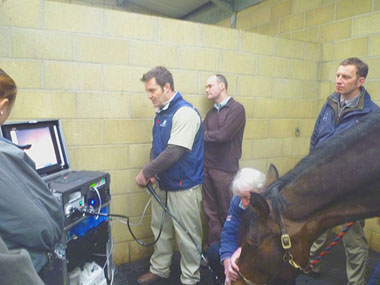First Equine Gastric Ulcer Study Launched
 13 years ago
13 years ago  3513 views
3513 views
Posted
1st May, 2013 17h34
 Richard Hepburn and delegates at the National Ulcer Study launch in Stow
Delegates at the launch of a large scale equine gastric ulcer study were told that they will be making history by being part of the landmark project, which aims to improve understanding and knowledge of ulceration in performance horses.
Thought to be the world’s first study of its kind, 21 appointed practices across the UK attended the briefing by Richard Hepburn MRCVS. Mr Hepburn is conducting the InnerVision study of performance horses which is being championed by the University of Liverpool, as part of his PhD.
Each practice is scoping between 10 and 20 horses, so the study will include well over 200 performance horses said Mr Hepburn. “Gastric ulceration in sports horses is poorly understood, especially compared with racehorses. But what we do know is that it’s a very important factor in the performance and well-being of many horses in training and competition.”
Also attending the launch was 2012 Paralympic Gold medallist Deb Criddle MBE. She explained the difference that regular gastroscopy and ulcer management of Paralympic team horses had made to her success. Speaking about her Beijing ride, Pavaroti, she said: “If it weren’t for the diagnosis and treatment of Pavaroti’s ulcers I don’t know what we’d have done. I would probably have had to withdraw him from training, so it made the difference between our partnership continuing or not,” she explained.
Mr Hepburn expects a prevalence of approximately 60% and, keen to increase understanding of glandular ulceration, participants are being tasked to scope all areas of the stomach, pylorus and duodenum to ensure that every incidence of ulceration is diagnosed and recorded.
And he is particularly eager to find out more about glandular disease, which hitherto has had little research. “Glandular disease appears to have a very different aetiology to squamous ulceration, and often presents with different signs,” explained Mr Hepburn. “We also believe that prevalence of glandular ulceration is most common in sports horses.”
Thanking Merial for assisting with the study management, Mr Hepburn concluded by discussing plans for publication of the study. “We hope that publication of this study will help all equine vets in their work with performance horses and the quest to prevent and manage equine ulcers,” he added.
Richard Hepburn and delegates at the National Ulcer Study launch in Stow
Delegates at the launch of a large scale equine gastric ulcer study were told that they will be making history by being part of the landmark project, which aims to improve understanding and knowledge of ulceration in performance horses.
Thought to be the world’s first study of its kind, 21 appointed practices across the UK attended the briefing by Richard Hepburn MRCVS. Mr Hepburn is conducting the InnerVision study of performance horses which is being championed by the University of Liverpool, as part of his PhD.
Each practice is scoping between 10 and 20 horses, so the study will include well over 200 performance horses said Mr Hepburn. “Gastric ulceration in sports horses is poorly understood, especially compared with racehorses. But what we do know is that it’s a very important factor in the performance and well-being of many horses in training and competition.”
Also attending the launch was 2012 Paralympic Gold medallist Deb Criddle MBE. She explained the difference that regular gastroscopy and ulcer management of Paralympic team horses had made to her success. Speaking about her Beijing ride, Pavaroti, she said: “If it weren’t for the diagnosis and treatment of Pavaroti’s ulcers I don’t know what we’d have done. I would probably have had to withdraw him from training, so it made the difference between our partnership continuing or not,” she explained.
Mr Hepburn expects a prevalence of approximately 60% and, keen to increase understanding of glandular ulceration, participants are being tasked to scope all areas of the stomach, pylorus and duodenum to ensure that every incidence of ulceration is diagnosed and recorded.
And he is particularly eager to find out more about glandular disease, which hitherto has had little research. “Glandular disease appears to have a very different aetiology to squamous ulceration, and often presents with different signs,” explained Mr Hepburn. “We also believe that prevalence of glandular ulceration is most common in sports horses.”
Thanking Merial for assisting with the study management, Mr Hepburn concluded by discussing plans for publication of the study. “We hope that publication of this study will help all equine vets in their work with performance horses and the quest to prevent and manage equine ulcers,” he added. More from
- Vetsure Named Business of the Year at 2025 SME National Business Awards
- Home of hope for Romania's dogs: The pioneering shelter doing things differently
- Pioneering new locum platform transforming veterinary landscape
- Key Stakeholders unite to advance helmet design for equine veterinary professionals
- Hallmarq hails transformational equine imaging technology

 3 hours ago
3 hours ago